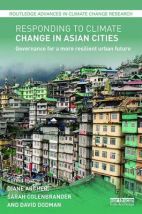Responding to Climate Change in Asian Cities: Governance for a More Resilient Urban Future

Edited by Diane Archer, Sarah Colenbrander and David Dodman, Responding to Climate Change in Asian Cities illustrates the overarching importance of urban adaptive governance for building climate resilience and thus sustainable development. Incorporating themes of inclusion and urban climate justice, this book emphasizes the linkages between development and adaptation in cities of low- and middle-income countries. It draws on the experiences of South and Southeast Asian cities to adapt to climate change and overcome barriers to building urban resilience. Specifically, it proposes a model of adaptive urban governance that is flexible and responsive, and that reduces risks and increases benefits for all urban residents, with particular attention to the poor and marginalized.
This book sheds light on how local action can build more resilient urban centres. It is therefore relevant for planners, policymakers, and development and climate change practitioners, as well as scholars in the fields of urban studies, sustainability, environmental studies, development studies, and Asian studies.
Responding to Climate Change in Asian Cities starts with an introduction written by its editors. This describes climate vulnerability in Asia and the terms “urban resilience” and “adaptive governance”. It also gives an overview of the book’s 10 chapters, which are divided across three parts: Actors (Chapters 1–3), Knowledge (Chapters 4–6), and Institutions (Chapters 7–10). These chapters started as working papers for the Asian Cities Climate Change Resilience Network (ACCCRN), and demonstrate a variety of pilot strategies to build resilience in cities of India, Bangladesh, Vietnam, the Philippines and Indonesia.
With a focus on climate justice, social protection, and just adaptation, Chapter 1 commences by examining the vulnerability contexts of migrant workers in three Indian cities: Surat, Kochi and Mumbai (page 17).
Chapter 2 presents a study of three Asian cities in Bangladesh, the Philippines and Vietnam in order to explore the intersection of rights, risks and vulnerabilities of urban children. It discusses resilience building in both cities and children – also known as the 3Rs approach to child-centred climate change adaptation (page 33).
Drawing upon the experience of Dhaka, Bangladesh, Chapter 3 explores how multi-stakeholder collaboration can be improved for a more resilient water and sanitation sector. It also identifies “the impacts of climatic events of water and sanitation infrastructure and services in slums in Dhaka” (page 57).
Chapter 4 turns to coastal development in the city of Quy Nhon, Vietnam. In light of climate change planning, it examines the impacts of both historic and future urban growth, expansion and shoreline development, and considers possibilities for building climate resilience (page 76).
Reflecting on the ACCCRN experiences in seven Indian cities, Chapter 5 assesses the potential for replicating climate resilience planning in other Indian cities. It also identifies the importance of institutions for city-level action and informed decision-making (page 90).
Learning from Indonesia, Chapter 6 evaluates different climate change vulnerability assessments (CCVAs) in four cities and makes recommendations for future CCVA processes to improve climate resilience outcomes (page 108).
Chapter 7 examines water provision and the institutional structure of water supply in Peri-Urban Can Tho, Vietnam. It sets forth the institutional challenges and solutions for improving coordination mechanisms for the water supply sector in this area (page 127).
Looking through the lens of water insecurity as a type of vulnerability in cities, Chapter 8 cites the example of Baguio City, in the Philippines, to highlight “the issue of governance as a crucial component of urban resilience” (page 146).
Chapter 9 seeks to model local demand for index-based insurance for catastrophic floods in Da Nang, Vietnam. It then makes policy recommendations to public and private actors who may seek to make such insurance services available to local communities (page 166).
Finally, Chapter 10 studies local government planners’ perspectives of climate change impacts and adaptation policy, mainstreaming and planning in seven Indonesian coastal cities (page 182).
Dodman, Colenbrander and Archer close by highlighting the relevance of the book’s case studies and model of adaptive urban governance for the New Urban Agenda. They also discuss how adaptive urban governance may play out practically for decision-makers engaging with actors, knowledge and institutions (page 202).
Book note prepared by Hannah Keren Lee
Search the Book notes database
Our Book notes database contains details and summaries of all the publications included in Book notes since 1993 - with details on how to obtain/download.
Use the search form above, or visit the Book notes landing page for more options and latest content.
For a searchable database for papers in Environment and Urbanization, go to http://eau.sagepub.com/

